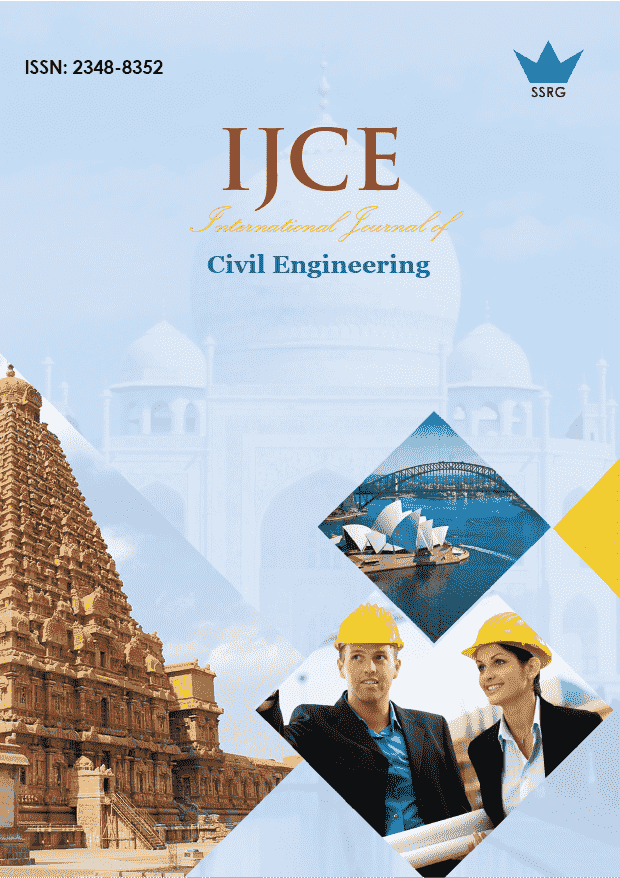Risk Assessment and Health Risk Index Development of Municipal Solid Waste

| International Journal of Civil Engineering |
| © 2019 by SSRG - IJCE Journal |
| Volume 6 Issue 5 |
| Year of Publication : 2019 |
| Authors : Krishna Kumar Singh,Rakesh Chandra Vaishya |
How to Cite?
Krishna Kumar Singh,Rakesh Chandra Vaishya, "Risk Assessment and Health Risk Index Development of Municipal Solid Waste," SSRG International Journal of Civil Engineering, vol. 6, no. 5, pp. 30-43, 2019. Crossref, https://doi.org/10.14445/23488352/IJCE-V6I5P106
Abstract:
Rapid urbanization leads to the generation of municipal solid waste, which creates problems for humans and the environment in the long run. Risks for a human being is one of the common deterioration of the environment, the assessment of environmental risk is very important at present. This paper presents the new concept of identifying risk assessment areas in municipal boundaries & health risk index developed from municipal solid waste. This study has been designed to evaluate the health risk index and determine the risk assessment areas from municipal solid waste in four municipal wards of the Allahabad city, India, using the Aggregation model and Multi-dimensional Comparative Analysis (MCA) Model.
The effects assessed were the possible impacts of solid waste on health and the environment. The resident's view regarding the location of the primary transfer of municipal solid waste was also taken. The data collection route was descriptive, analytical, and survey-based (questionnaires and field observations). The result shows that both residents & sweepers living near the primary transfer stations of municipal solid waste in the city were affected by skin diseases, eye irritation, Nausea & vomiting, malaria, chest pains, cholera, and diarrhea, etc. The final obtained ranking of sustainable development health risk indexes of solid waste of each municipal ward indicates that the 1st rank in high health risk area to the last rank in the lowest health-risk area.
Keywords:
Municipal solid waste, Risk Assessment, Health Impact, Aggregation model, MCA model, Allahabad Nagar Nigam.
References:
[1] Al-Khatib IA and Sato C,. Solid health care waste management status at health care centers in the West Bank. Palestinian Territory. Waste Management. 29, (2009),2398–2403.
[2] Antonopoulos, I. S., Perkoulidis, G., Logothetis, D., Karkanias, C., Ranking municipal solid waste treatment alternatives considering sustainability criteria using the analytical hierarchical process tool. Resources, Conservation and Recycling, 86, (2014), 149-159.
[3] Ayomoh, M.K.O.; Oke, S.A.; Adedeji, W.O.; Charles-Owaba, O.E,. An approach to tackling the environmental and health impacts of municipal solid waste disposal in developing countries. J. Environ. Manag, 88,(2008),108–114.
[4] Central Pollution Control Board (CPCB), Management of Municipal Solid Waste. Ministry of Environment and Forests, New Delhi, India.
[5] Cheng, S., Chan, C. W., Huang, G. H.,. An integrated multi-criteria decision analysis and inexact mixed integer linear programming approach for solid waste management. Engineering Applications of Artificial Intelligence,16(5), (2003), 543-554.
[6] Chatterjee A., Mukherjee S. and Kar S., Poverty Level of Households. A Multi-dimensional Approach Based on Fuzzy Mathematics Fuzzy Information and Engineering 6,(2014), 463-487.
[7] D. Wawrzyniak,. Standard Of Living In The European Union, Comparative Economic Research, 19(1),(2016),141-155.
[8] Daniel, H., What a waste, solid waste management in Asia. Washington DC., (1999).
[9] Defra,. Review of environmental and health effects of waste management: Municipal solid waste and other similar wastes., (2004).
[10] Distaso A., Local sustainable development and well-being/quality of life. An application of the capability approach at regional level Quaderno 25,(23-26).
[11] Frazzoli, C.; Orisakwe, O.E.; Dragone, R.; Mantovani, A,. Diagnostic health risk assessment of electronic waste on the general population in developing countries’ scenarios. Environ. Impact Assess. Rev.30,388–399.
[12] Giusti, L,. A review of waste management practices and their impact on human health. Waste Manag., 29,(2009),2227–2239.
[13] Jain A. and Ganti S.,. A taxonomy for evaluation and comparison of financial performance of Indian IT companies Adarsh Journal of Management Research 8, (2015),1-13.
[14] K. Kompa, D. Witkowska,Comparison of European stock exchanges one-and multi-dimensional analysis, Indian Journal of Fundamental and Applied Life Sciences,4(S1), (2014),2111-2126.
[15] Kompa K. and Witkowska D., Synthetic measures of the European capital markets development Ekonometria. Econometrics 4,(2015), 216-22.
[16] Louis, G. E., A historical context of municipal solid waste management in the United States. Waste management & research, 22(4),(2004),306-322.
[17] Marshal, E., Analytic study to evaluate associations between dumpsites and birth effects. ATSDR CO.LTD: Atlanta., (1995).
[18] Mohammad S, Huda ATM, Hoque R., Household solid waste characteristics and management in Chittagong, Bangladesh. Waste Manage 28, (2007), 1688–1695.
[19] MufeedSharholy,Kafeel Ahmad, R.C.Vaishya, R.D.Gupta,. Municipal solid waste characteristics and management in Allahabad, India. Waste Management., 27(4),(2007),490-496.
[20] Nor, Z. Md., Kecojevic, V., Komljenovic, D., Groves, W., Risk assessment for loader- and dozer-related fatal incidents in U.S. mining, International Journal of Injury Control and Safety Promotion., 15,(2008),65–75.
[21] National Research Council (NRC), Risk assessment in Federal Government: Managing the process. National Academic Press, Washington, D.C., (1983).
[22] Pomianek I., Socio-economic development of agricultural problem areas in Poland Economics & Sociology.,7, (2014), 218-235.
[23] Sadiq R, Haji SA, Cool GV, Rodriguez MJ,. Using penalty functions to evaluate aggregation models for environmental indices. J Environ Manage, 91(3),(2010),706–716.
[24] Seadon, J. K., Integrated waste management–Looking beyond the solid waste horizon. Waste management, 26(12), (2006),1327-1336.
[25] Sharholy, M., Ahmad, K., Vaishya, R.C., Gupta, R.D., Journal of Waste Management 27(4), (2007),490–496.
[26] UNEP,. Environmental risk assessment for sustainable cities. IETC Technical Publication Series,. UNEP International Environmental Technology Center, Osaka/Shiga.,3,(1996).
[27] Worrell, W., Vesilind, P.,Solid Waste Engineering, SI Version. Cengage Learning. (2012).
[28] G. Akhilesh ready, M.Suren Rao, Municipal Solid Waste Composition and Recycle Process, SSRG International Journal of Geoinformatics and Geological Science 3(3) (2016) 32-35.

 10.14445/23488352/IJCE-V6I5P106
10.14445/23488352/IJCE-V6I5P106